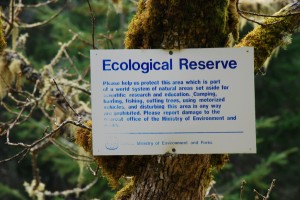
News/Reports
Mount Tzuhalem Overview: Physical and Biological
Original Purpose: To preserve outstanding Garry oak-wildflower communities
Physical:Mount Tzuhalem consists of strongly bedded conglomerates and sandstones. The reserve, at middle elevations on the western side of the mountain, faces southwest and has strongly sloping, internally hilly terrain. Soils, where developed, are shallow Sombric and Dystric Brunisols. Hollows between rock outcrops may contain seepage water in spring, but the whole area dries out quickly in summer.
See the BC Parks PDF for the complete version of this document: Mount Tzuhalem ER 112
Biological:Groves of Garry oak separated by wildflower meadows and mossy outcrops, together with scattered, gnarled, Douglas-fir and arbutus trees, give the site a parkland appearance. The dense, showy wildflower stands are at their best in April and May. Seven plant communities have been described.
Garry oak-common snowberry woodland occurs on the deeper soils and among rock outcrops. Douglas-fir and arbutus are present, and conspicuous shrubs are ocean-spray and tall Oregon-grape. The wildflower meadows, dominated by camas and sea blush, occur on shallow soils subject to summer drought. Six or more species of grass occur in the meadows, of which Kentucky bluegrass and sweet vernalgrass are most common. Legumes are also diverse, including bicolored lupine, bird’s-foot trefoil, four species of clover, and two vetches. Showy subdominant wildflowers are shooting stars, western buttercup, field chickweed, dovefoot geranium, death-camas, fool’s-onion, yarrow, chocolate lily, Menzie’s larkspur, Hooker’s onion, and forget-me-nots. Wet hollows in the meadows commonly support grassland saxifrage, blinks, and narrow-leaved montia. A fringe community, dominated by tall Oregon-grape and white fawn lily, sometimes forms a transition between oak woodlands and camas meadows. Four other communities are associated with rocky habitats.
Cultural:The Tzuhalem area is an historical harvesting location for the Vancouver Island Coast Salish First Nations. The reserve is a camas harvesting site which was traditionally burned to increase yields and maintain the open park-like habitat.
Significant species: Red listed:
Garry oak-California brome association ,Garry oak-oceanspray association ,deltoid balsamroot, purple sanicle,white meconella, Scouler’s catchfly,small-flowered godetia yellow montane violet,white-top aster
Blue Listed:
California-tea,Ermine, ssp. anguinae, farewell-to-spring ,Nutall’s quillwort,
arbutus,coast Douglas-fir ,common camas ,Garry oak, Golden-crowned Sparrow ,Hermit Thrush Hooker’s onion,
Northern Flicker
Threats,
Climate change:Garry oak ecosystems are endangered in this province, largely due to rural and urban development. As the projected climate becomes warmer and drier, Garry oak ecosystems may theoretically fare well considering the favourable environment, but this would require appropriate land management and the creation and/or maintenance of ecological corridors.
Harvest: The illegal harvest of Deltoid balsam-root, chocolate lily, camas and fawn lilies occurs within the reserve. These are rare native species that are being harvested for personal landscaping and possibly commercial sale.
Non-native species:Scotch Broom,St.john’s wort and Orchard Grass are displacing native species.are displacing native species.
Recreation: Non-regulated foot-traffic occurs within reserve.
Urban and/or rural development: Development is encroaching on the boundary of the reserve.
Flora:
arbutus (Arbutus menziesii) aster, white-top (Aster curtus) balsam-root, deltoid (Balsamorhiza deltoidea) blinks (Montia fontana) bluegrass, Kentucky (Poa pratensis) buttercup, western (Ranunculus occidentalis var. occidentalis) camas, common (Camassia quamash) catchfly, Scouler’s Silenescouleri ssp. grandis)
chickweed, field (Cerastium arvense)
death-camas (Zigadenus sp.)
Douglas-fir, coast (Pseudotsuga menziesii var. menziesii)
farewell-to-spring (Clarkia amoena)
fools-onion (Triteleia hyacinthina)
forget-me-not (Myosotis spp.)
geranium, dovefoot (Geranium molle)
godetia, small-flowered (Clarkia purpurea spp. quadrivulnera)
larkspur, Menzies’ (Delphinium menziesii)
lily, chocolate (Fritillaria affinis)
lily, white fawn (Erythronium oregonum)
meconella, white (Meconella oregana)
montia, narrow-leaved (Montia linearis)
oak, Garry (Quercus garryana)
ocean-spray (Holodiscus discolour)
onion. Hooker’s (Allium acuminatum)
Oregon-grape, tall (Mahonia aquifolium)
quillwort, Nutall’s (Isoetes nuttallii)
sanicle, purple (Sanicula bipinnatifida)
saxifrage, grassland (Saxifraga integrifolia)
seablush (Plectritis congesta)
shootingstar (Dodecatheon pulchellum ssp.)
St.John’s wort (Hypericum sp.)(may be invasive)
trefoil, bird’s-foot (Lotus corniculatus)
vernalgrass, sweet (Anthoxanthum odoratum)
violet, yellow montane (Viola praemorsa ssp. praemorsa)
yarrow (Achillea spp.)
I n v a si v e
broom, Scotch (Cytisus scoparius)
orchard-grass (Dactylis glomerata)
Fauna
Ermine,anguinae subspecies (Mustela erminea anguinae)
Flicker, Northern (Colaptes auratus)
Sparrow, Golden-crowned (Zonotrichia atricapilla)
Thrush, Hermit (Catharus guttatus)

